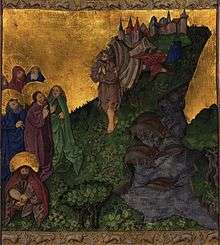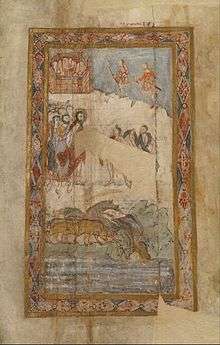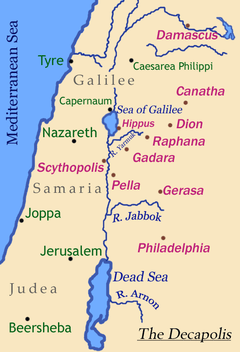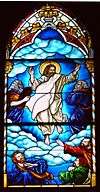Exorcism of the Gerasene demoniac

The exorcism of the Gerasene demoniac, frequently known as the Miracle of the (Gadarene) Swine, is one of the miracles performed by Jesus according to the New Testament.[1] The story shows Jesus exorcising a demon or demons out of a man and into a herd of swine, causing the swine to run down a hill into a lake and drown themselves.
The story appears in the three Synoptic Gospels, but not the Gospel of John. All accounts involve Jesus exorcising demons, identified collectively in Mark and Luke as "Legion".
The story was interpreted by Saints Augustine of Hippo and Thomas Aquinas to mean that Christians have no duties to animals.[2] It has been a point of contention in discussions of Christianity and animal rights.[3]
Narratives
Mark
The earliest account is from the Gospel of Mark (Mark 5:1-20), in which Jesus goes across the sea into the "region of the Gerasenes".[4] There, a man "possessed by a demon" comes from the caves to meet him. People had tried to tie him down but he was too strong to be bound, even with chains for he would always break out of them; night and day among the tombs and in the hills he would cry out and cut himself with stones. Jesus approaches and calls the demon to come out of the man, who replies "What do you want with me, Jesus, Son of the Most High God? I beg you in the name of God never to torment me!" Jesus asks the demon for his name and is told "My name is Legion, for we are many". The demons beg Jesus not to send them away, but instead to send them into the pigs on a nearby hillside, which he does. The herd, about two thousand in number, rush down the steep bank into the sea and are drowned. The man is now seen, dressed and restored to sanity: he asks to be included among the disciples who travel with Jesus but he is refused and instructed to remain in the Decapolis region, to tell of "the great things the Lord has done ... and [how he] has had compassion on you". Theologian Tom Wright calls him "the first apostle to the gentiles".[5]
Matthew
The author of the Matthew Gospel shortens the story more dramatically (Matthew 8:28-34) and writes not of one possessed man, but of two.[6] In this version, Jesus does not ask for the demon's name – an important element of traditional exorcism practice.[7]
The location is also changed to the region of the "Gadarenes" (Gadara) as in most Bible translations. The King James Version in (Matthew 8:28) has the location as "Gergesenes" which corresponds to the modern "Kursi" (Kheras), the most plausible location of the Gospel event.
Luke
The Lucan gospel version (Luke 8:26-39) shortened this but retained most of the details.[6]
Commentary
Gerasa, Gadara, or Gergesa?

The story appears to be set close to the Sea of Galilee, but neither Gadara nor Gerasa is nearby; both cities are southeast of the lake, Gadara 10 km away or a three-hour walking distance, and Gerasa well over twice as far. Origen speculated that there had been a town called "Gergasa" on the shores of the Sea.[8]
The differing geographical references to Gadara and Gerasa can be understood in light of the social, economic, and political influence each city exerted over the region. In this light, Matthew identified the exorcism with the local center of power, Gadara, located about ten kilometres southeast of Sea of Galilee, whereas Mark identified the event with the regional center of power, Gerasa, located further inland.[9] The city of Gerasa had been a major urban center since its founding and during the Roman period it was the more widely known among the ten-city league known as the Decapolis.
As to the candidate for the location of the Gospel event, both Gerasa about 50 km (31 miles) and Gadara (Umm Qais) about 10 km (6 miles) from the coast of the Sea of Galilee do not fit in the Gospel narratives. The most plausible one is Kursi, which is on the eastern shore of the Sea of Galilee, on the foothills of the Golan Heights.
Naming, and use of singular and plural
The revealing of the demon's name has parallels with other examples in Jewish exorcism lore in the Second Temple period.[10] The switching between singular and plural pronouns in the synoptic accounts are considered by some commentators to illustrate the afflicted man's confused identity. In the initial encounter with Jesus the man speaks in the singular, but switches to plural.[11]
Historical and biblical context
It has been widely accepted by scholars that several motifs throughout the account refer to the Roman legion. Further possible echoes include Isaiah 65:4 with parallels to both graves and swine:[12]
- "A people who ... sit among the graves, and spend the night in the tombs;
- Who eat swine's flesh, and the broth of abominable things is in their vessel".
Animal rights

Classical theological commentary cited this story to argue that animals have no moral importance in Christianity.[13] Saint Augustine of Hippo concluded from the story that Christians have no duties towards animals,[2] writing:
Christ himself shows that to refrain from the killing of animals and the destroying of plants is the height of superstition, for judging that there are no common rights between us and the beasts and trees, he sent the devils into a herd of swine and with a curse withered the tree on which he found no fruit.[14]
Similarly, Thomas Aquinas argued that Jesus allowed the demons to destroy the pigs in order to make the point that his purpose was primarily for the good of men's souls, not their bodies or property (including their animals).[3] This interpretation has been shared by a long line of commentators up to the present day, including I. Howard Marshall and Mark Driscoll.[3] However, other commentators have attempted to make the story consistent with a Jesus who shows "care and concern for animals," as John Austin Baker wrote.[14][3] Such alternative readings include arguments that the swine were meant to represent the Roman army or "unclean and unfaithful" people; that pigs were considered "unclean", so destroying them might be consistent with care for other animals; and that Jesus did not actually "send" the devils into the pigs.[3][13][14]
Proverbial use
The story is the origin of the English proverbial adjective Gadarene, meaning "involving or engaged in a headlong or potentially disastrous rush to do something".[15]
See also
References
- ↑ The Life and Ministry of Jesus: The Gospels by Douglas Redford 2007 ISBN 0-7847-1900-4 page 168
- 1 2 Honderich, T. (2005). The Oxford Companion to Philosophy. Oxford Companions. p. 37. ISBN 978-0-19-926479-7.
- 1 2 3 4 5 Spalde, Annika; Strindlund, Pelle (2012). "Doesn't Jesus Treat Animals as Property?". In York, T.; Alexis-Baker, A.; Bekoff, M.; McLaren, B. A Faith Embracing All Creatures: Addressing Commonly Asked Questions about Christian Care for Animals. Peaceable Kingdom Series. Wipf & Stock Publishers. p. 102. ISBN 978-1-61097-701-2.
- ↑ Other textual variations include "Gadarenes" and "Gergesenes".
- ↑ Wright, T., Mark for Everyone, 2001, p. 57
- 1 2 Donald Senior, What are They Saying about Matthew? (Paulist Press, 1996) page 84.
- ↑ Craig S. Keener, A Commentary on the Gospel of Matthew (Wm. B. Eerdmans Publishing, 1999) page 282.
- ↑ M. Eugene Boring, Mark: A Commentary (Presbyterian Publishing Corp, 2006) pages 148–149.
- ↑ McArthur, Dr. John (1987). Matthew 8-15. MacArthur New Testament Commentary. The Moody Bible Institute of Chicago. p. 41. ISBN 0-8024-0763-3.
- ↑ R. Barthes, F. Bovon, F. J. Leenhardt Structural Analysis and Biblical Exegesis: Interpretational Essays 1974 -0915138026 "To force him to surrender his name is to make him more vulnerable to the grasp of the exorcist. Now the name that the demon surrenders to Jesus is a collective singular: "Legion is my name", --- (5:9). This name (although in the singular) is a multiplying term."
- ↑ James L. Resseguie Narrative Criticism of the New Testament: An Introduction 0801027896 2005 p116 "He is captive to an alien, occupying force, “swallowed up by his possessing spirit,”59 and the opposition (i.e., the legion of demons) does not wait to be vanquished but comes out to negotiate favorable terms with the superior power. The singular and plural pronouns underscore the man's divided, confused identity. The demon-possessed man is singular yet multiple. In the initial encounter with Jesus he speaks in the singular: “What have you to do with me, Jesus, Son of the Most High ...
- ↑ Brown, Raymond E. et al., The Jerome Biblical Commentary, Englewood Cliffs, New Jersey: Prentice–Hall Inc., 1968, p. 32.
- 1 2 Preece, R.; Chamberlain, L. (2010). Animal Welfare and Human Values. Wilfrid Laurier University Press. p. 16. ISBN 978-1-55458-767-4.
- 1 2 3 Linzey, A. (2016). Christianity and the Rights of Animals. Wipf & Stock Publishers. p. 48. ISBN 978-1-4982-9195-8.
- ↑ The Oxford Dictionary of Phrase and Fable, 2006
External links


